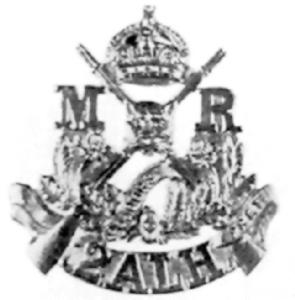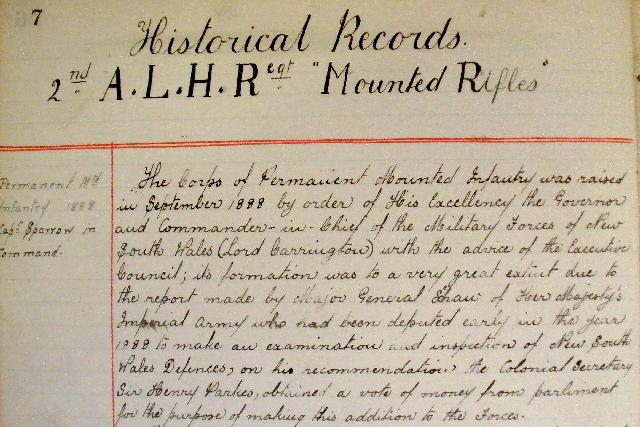Topic: Militia - LHN - 2/9/6
NSWMR
New South Wales Mounted Rifles
History, Part 1, 1888 - 1889
New South Wales Mounted Rifles [1888 - 1903]
2nd (New South Wales Mounted Rifles) Australian Light Horse [1903 - 1912]
9th (New South Wales Mounted Rifles) Australian Light Horse [1912 - 1918]
6th (New South Wales Mounted Rifles) Australian Light Horse [1918 - 1941]
6th (New South Wales Mounted Rifles) Motor Regiment [1941 - 1943]
6th Australian Armoured Car Regiment [1941 - 1943]
6th (New South Wales Mounted Rifles) Motor Regiment [1948 - 1949]
6th New South Wales Mounted Rifles [1949 - 1958]
Royal New South Wales Regiment [1958 - 1960]

Toujours pret - Always Ready
Allied with: King Edward's Horse (The King's Overseas Dominions Regiment).
The following is the first extract from a manuscript written by an anonymous author. The hand written manuscript outlines the history of the 2nd ALHR NSW Mounted Rifles from commencement in 1888, until 5 April 1899, when history ceases. From the internal evidence of the manuscript, it appears to have been composed sometime from July 1903 to 1904.

The first extract from the manuscript.
2nd ALHR Mounted Rifles
Permanent Mounted Infantry 1888, Captain Sparrow in Command.
The Corps of Permanent Mounted Infantry was raised in September 1888 by order of His Excellency the Governor and Commander in Chief of the Military Forces of New South Wales (Lord Carrington) with the advice of the Executive Council; its formation was to a very great extent due to the report made by Major General Shaw of Her Majesty's Imperial Army who had been deputed early in the year 1888 to make an examination and inspection of the New South Wales Defences, on his recommendation the Colonial Secretary, Sir Henry Parkes, obtained a vote of money from parliament for the purposes of making this addition to the Forces.
The Corps was intended to supply men and horses for instructional purposes to the Officers of the mounted branched, and to form the nucleus of a Regiment to be distributed by companies throughout the colony.
The officer appointed to command the Corps was Captain Henry Glendower Bodycham Sparrow who was transferred from the Adjutancy of the "Northern Reserves."
The establishment consisted of one Captain, one Sergeant and thirty men.
Recruiting commenced on the 11th September 1888, at Victoria Barracks, Sydney, the first enrolment being Richard Holman (Now Warrant Officer and Regimental Sergeant Major of the New South Wales Mounted Rifles); a large number of the men presented themselves for attestation, each candidate was required to pass a successful trial of horsemanship before enlistment, and none were accepted below the height of 5 feet 7 inches, with a minimum chest measurement of 34 inches.
The establishment having been speedily obtained, the men were grounded in the rudiments of foot drill, and gymnasium work until December 1888, when the horse arrived from Neotsfield Station, they were handled and broken by a selected number of men for duty in the ranks.
The Corps was employed chiefly on Escort, Orderly and Guard duties, its first public appearance being in February 1889, when by command of His Excellency, the Governor, Lord Carrington, they were inspected by him at Government House.
The first guard furnished was at Government House in July 1889. The Corps was popular with the inhabitants of the city, and gained much distinction by the particularly smart appearance of its members, and their good conduct.
Captain Lassetter to Command, 1889.
Early in January 1889, Captain Henry Beauchamp Lassetter of "Her Majesty's 80th Regiment of Foot", and a native of the colony, arrived in Sydney to take command of the Corps, and to perform in addition, the duties of Adjutant to the Lancer Regiment.
Mounted Infantry Regiment formed 1889.
During the first few weeks that Captain Lassetter occupied this dual position he spared neither time nor energy to promote and encourage his new Military factor, with the result that before Easter 1889, the Upper Clarence Light Horse, the Field Battery of Artillery at Bega and the companies of Reserves at Queanbeyan, Picton, Campbelltown and Inverell were selected to form together with the Permanent Company stationed in Sydney, an administrative Regiment under the partially-paid system, with Major Lassetter as Commanding Officer, and Captain Sparrow as Adjutant, the latter officer being also in command of the Permanent Company.
Each of the partially-paid companies consisting of 3 Officers and 47 rank and file, who received an annual allowance of pay according to rank, which was paid for attendance at drill and training, the maximum a private could earn was £12/-/- per annum at the rate of 10/- per day.
Inscription of Clothing and Equipment.
The following is a brief description of the clothing and equipment worn by the Regiment, the buttons and mounting of the Permanent Company being brass, the remainder white metal.
Jacket:Drab tweed, with four outside patch pockets, two at breast and two at waist with flaps, red cloth shoulder straps; the Permanent Company wore the Regimental Badge on shoulder strap and partially-paid men to letter of their company.
Riding Pants:Drab Bedford cord, fitting tightly.
Hat:Drab soft felt, turned up at left side enclosing a white puggaree and plume of black cock feathers, the brim fastening back with the regimental badge.
Leggings:Brown leather laced at side.
Overalls:Drab tweed with ½ inch red wilt down leg.
Cap:Drab tweed piped with red of field service pattern.
Gauntlets:Brown leather with buff tops.The Equipment
The Equipment was of brown leather throughout, and consisted of the following articles.
Waist Belt and Frog carrying Long Sword Bayonet.
Bandolier for 50 rounds, worn over left shoulder.
Haversack, white, ordinary infantry pattern.
Water Bag, white canvas, carried on saddle.
Clasp Knife and Lanyard, as used in Navy.
Saddle, ordinary bush pattern, and supplied by men.
Numnah, brown felt.
Valise, worn at rear of saddle.
Great Coat, black cloth of Infantry pattern.
Breastplate, Head Collar, Pelham Bit, and two reins.
An Artillery pattern Carbine carried in a leather bucket on the saddle, and a Cavalry pattern Mess Tin completed the equipment.
Regimental Badge, Southern Cross, surrounded with wreath of Waratahs, having a crown on top and lion rampant in centre of cross.
Encampment 1889.
On the 19th April 1889 the Regiment assembled for the first time and marched to the National Park to participate in the annual manoeuvres at Easter, of the troops; extending over nine days; the inauguration of the Regiment met with so much approval on all sides, and was commented upon in such glowing terms by the press, that shortly after the conclusion of training, numerous applications, memorials and petitions were made or raised throughout the colony and presented to Parliament, praying for an extension of this branch of the service.
The Sydney Morning Herald in a leading article dated 22nd April 1889 says:"One of the most hopeful of our land forces is the Mounted Infantry, which has been established lately, and a few years should give us a force of men most valuable in case of War."
Writing of the camp in general, the same contemporary of the same date says:"The great feature of the camp is the Mounted Infantry in their smart uniform under the command of Major AB Lassitter of the 80th (South Staffordshire) Regiment, whose appointment was gazetted at the beginning of the year. A finer body of men it would be difficult to get together. In some instances the men rode 60 to 85 miles to the railway station. The Regiment marched into camp 185 strong exclusive of Bega and Queanbeyan Companies which have not gone under canvas owing to their equipment being incomplete."
The Sydney Morning Herald of the 23rd April 1889 says:"The Mounted Infantry commenced an attack on an enemy near the railway heights, they seized the position and scattered the enemy, this action stamped the riders as most capable, in fact brilliant horsemen, besides proving the undoubted mettle of their steeds."
The same paper of April 24th 1889 says""The special feature of the days work was a sham fight arranged by Major Lasseter of the Mounted Infantry; it was viewed from start to finish by the General Officer Commanding and his staff, who exhibited the deepest interest in the movements of Major Lassetter's handsome little corps. This Corps must prove a tower of strength and usefulness in any and every conflict in which they may take part in the far or near future. The work done on the previous day was magnificent in every respect, and every body after hearing of the daring ride, was anxious to come and look on today and to follow the brilliant horsemen as best they could. Major General Richardson exhibited the keenest interest in the proceedings, and congratulated Major Lassetter upon his fine force; indeed it is impossible to bestow upon them too much praise."
In a leading article of April 29th 1889 this daily paper says:"In two most important particulars, this years exercises have been satisfactory and instructive. In the first place the value of the Mounted Infantry as a defence body has been clearly established. The most brilliant services have been rendered in the other lands by the Mounted Infantry, and if occasion should require, the same might be expected from this newly formed body amongst us. On Friday the display made by them at the sham fight was marked by dash and great activity. The government should push as fast as possible the formation of these corps in rural districts."
The companies stationed at Bega and Queanbeyan were fully clothed and equipped in June 1889 and marched to Moore Park, Sydney, together with the Permanent Company for a twelve days course of training.
Speaking of the Bega men, the Sydney Morning Herald of June 8th 1889 says:"The hardship which men undergo in coming into camp are seldom understood by the public, and rarely realised by any but the men themselves. The Bega men left home at 7am on June 5th, with a fifty mile ride before them to Nimitybelle. The country was in a dreadful state from wet weather, and bad enough to prevent the progress of the most daring horsemen, but the men were determined at all hazards to reach Sydney and so they forced their way along most difficult and almost impassable roads, climbing up 7 miles to pass over a mountain 4,000 feet above the sea level."
His Excellency, the Governor visited the camp on June 11th 1889, and was entertained by the officers; during the afternoon a programme of Military Sports was carried out in the presence of His Excellency, who was much pleased with the feats of Horsemanship.
The training was conducted under Major Lassetter who kept all ranks hard at work up till the last day, the camp broke up on the 16th June 1889.
Previous: 2nd/9th/6th Australian Light Horse
Next: New South Wales Mounted Rifles, History, Part 2, 1890
Further Reading:
2nd/9th/6th Australian Light Horse
Militia Light Horse, New South Wales
Australian Militia Light Horse
Citation: New South Wales Mounted Rifles, History, Part 1, 1888 - 1889



